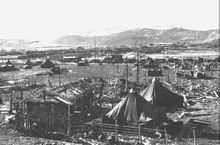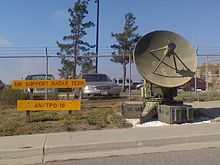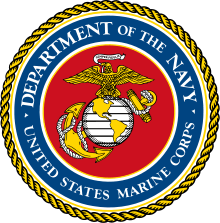Direct Air Support Center

The Direct Air Support Center (DASC) is the principal United States Marine Corps aviation command and control system and the air control agency responsible for the direction of air operations directly supporting ground forces. It functions in a decentralized mode of operation, but is directly supervised by the Marine Tactical Air Command Center (TACC) or the Navy Tactical Air Control Center (NTACC). During amphibious or expeditionary operations, the DASC is normally the first MACCS agency ashore and is usually categorized (i.e.,scheduled or on call wave) as the Ground Combat Element's (GCE's) senior Fire Support Coordination Center (FSCC). The DASC's parent unit is the Marine Air Support Squadron (MASS) of the Marine Air Control Group (MACG).
Role
The DASC processes immediate air support requests; coordinates aircraft employment with other supporting arms; manages terminal control assets supporting GCE and combat service support element forces; and controls assigned aircraft, unmanned aerial vehicles (UAVs), and itinerant aircraft transiting through DASC controlled airspace. The DASC controls and directs air support activities that effect the GCE commander's focus on close operations and those air missions requiring integration with the ground combat forces (close air support [CAS], assault support and designated air reconnaissance). The DASC does not normally control aircraft conducting deep air support (DAS) missions as detailed coordination of DAS missions is not required with ground forces. However, the DASC will provide battle damage assessments (BDAs) and mission reports (MISREPs) from DAS missions to the GCE's senior fire support coordination center (FSCC) and TACC when required.
History
World War II
The early forerunners of today's Tactical Air Control Party units were the Air Liaison Parties that accompanied the front-line divisions and served to request close air support and direct (but not control — the front was too narrow) aircraft to the target. Coordination of lower-echelon air requests became the province of four Landing Force Air Support Control Units (LFASCUs).
Korean War


Marine Tactical Air Control Squadron 2 (MTACS-2), the precursor to today's MASS-2, operated an Air Support section and conducted operations during the Korean War at the Pusan Perimeter, Battle of Inchon, Battle of Seoul, Battle of Chosin Reservoir, the East Central Front, and the Western Front.
What became to be known as the Marine Air Support Radar Team, (TPQ 10 - Devastate Charlie), all began at the Naval Air Missile Test Center, Point Mugu, CA in 1949. A small group of Marines, four officers (Captains Dalby, Johnston, Dressin and First Lt. Harris) and eight enlisted technicians (MSgts Hayden, Holtz, Dickover; TSgt Seissiger; SSgt Leber, Waggener, Darrow; and Cpl Gramza) formed an ad hoc Marine organization, called the Marine Guided Missile Section. With the assistrance of the German scientist Dr. Wagner the group conceived, built and tested a computer that would take the information from a tracking radar and provide the course for a LOON missile (the old German V-1) to fly to a designated target. At the computed time the wings were blown off the missile and it would fall toward the target. As missiles were in short supply during the testing period, a drone aircraft was flown as the missile and water filled bombs were dropped on the target. The tests revealed that an all weather bombing system had been developed that could provide close air support. The original radar in the system was an SCR 784 borrowed from the Army at Ft. Bliss TX. The computer was in a van and not packaged for combat. When it was decided to send the system to Korea the computer was repacked in a 1/4 Ton trailer and the SCR 784 was replaced with the radar TPQ 10. After tests in the area near El Centro and at Camp Pendleton, the original group was augmented with other Marines and the 1st MARST was born, assigned to the 1st WAW, MTACS-2(who was radio call sign DEVASTATE). The 1st MASRT was Devstate Charlie. The team joined the 1st Marine Division in reserve in June 1951. What was to be a relative short combat evaluation became extended when the effectiveness of the system dictated that the system remain as a regular unit in the Air Wing. Of the original group of Marines at NAMTC, Point Mugu only two survived; LtColonel Robert G. Harris and LtColonel John Seissiger. Both have since retired, and leader, Colonel M. C. Dalby died in 2008.
Vietnam

In April 1965, MASS-2 and MASS-3 deployed to the Republic of Vietnam as part of the III Marine Amphibious Force and provided two Direct Air Support Centers and five Air Support Radar Teams (ASRTs) in support of ground combat units. From 1966-1971, MASS-3 ASRTs controlled more than 38,010 AN/TPQ-10 missions, directing more than 121,000 tons of ordnance on 56,753 targets. (a 10:1 ratio) The ASRTs utilized the AN/TPQ-10 with great success, especially during the Battle of Khe Sanh, where poor weather made conventional Close air support methods unreliable. The AN/TPQ-10 had a 50-yard (46 m) Circular error probable and could handle up to 105 missions a day. The commander of the Khe Sanh defense, Col. David M. Lownds, said "Anything but the highest praise would not have been enough."[1] By the end of the war, the DASCs and ASRTs participated in virtually every major Marine combat operation.[2]
The 1980s and the Gulf War
In the early 1980s, the AN/TPQ-10 was replaced by the more sophisticated AN/TPB-1D, which, after extensive service in Operation Desert Storm, was removed from service due to the growing technological sophistication of onboard navigation and weapons delivery systems in modern fixed and rotary wing aircraft. During Operation Desert Storm the DASC was operational for 984 hours. They controlled 4948 fixed wing missions and 839 rotary wing missions. During this time they received 375 immediate joint tactical air requests (JTARs), 114 immediate assault support requests (ASRs) and 153 immediate medevacs.
Operation Iraqi Freedom
For the 2003 invasion of Iraq, the DASC for the I Marine Expeditionary Force was provided by MASS-3 with augmentation from MASS-1 and MASS-6. It was broken up into a main echelon (DASC Main) and a forward echelon (DASC Fwd). The main was attached to the Main Headquarters of the 1st Marine Division while the forward was attached to the Division "Jump Command Post (CP)." The DASC (Fwd) was also a part of Task Force in Al Anbar Province. MASS-1 again switched out with MASS-3 in early 2007 and currently provide air support for the 2nd Marine Division.
Tasks
- Receive the Air Tasking Order (ATO) from the TACC (Marine or Navy) and coordinate planned direct air support.
- Receive, process and coordinate requests for immediate direct air support.
- Adjust planned schedules, divert airborne assets, and launch aircraft as necessary when delegated authority by the aviation combat element (ACE) commander and in coordination with the Marine Air Ground Task Force (MAGTF)force fires coordination center (FFCC) or GCE senior FSCC.
- Coordinate the execution of direct air support missions with other supporting arms through the appropriate FFCC/FSCC and, as required, with the appropriate MACCS agencies.
- Receive and disseminate pertinent tactical information reported by aircraft performing direct air support missions.
- Provide aircraft and air control agencies with advisory and threat information to assist in the safe conduct of flight.
- Monitor, record and display information on direct air support missions.
- Maintain friendly and enemy ground situation displays necessary to coordinate direct air support missions.
- Provide direct air support aircraft and other MACCS agencies with information concerning the friendly and enemy situation.
- Refer unresolved conflicts in supporting arms to the FFCC/FSCC fire support coordinator (FSC).
Current Units
- Marine Air Support Squadron 1 (MASS-1) - 2nd Marine Aircraft Wing - Marine Corps Air Station Cherry Point, Cherry Point, North Carolina
- Marine Air Support Squadron 2 (MASS-2) - 1st Marine Aircraft Wing - Marine Corps Air Station Futenma, Okinawa, Japan
- Marine Air Support Squadron 3 (MASS-3) - 3rd Marine Aircraft Wing - Marine Corps Base Camp Pendleton, California
- Marine Air Support Squadron 6 (MASS-6) - 4th Marine Aircraft Wing - Marine Corps Air Station Miramar, California & Westover Air Reserve Base, Chicopee, Massachusetts
References
- ↑ Krulak, Victor H. (1984). First To Fight: An Inside View of the U.S. Marine Corps. Annapolis, Maryland: Naval Institute Press. ISBN 0-87021-785-2. Chapter 7, The Marines' Push Button 113-119
- ↑ United States Marine Corps (1986) Controlling Air Support - US Marines in Vietnam, 1970-1971: Vietnamization and Redeployment. Chapter 15.
External links
| |||||||||||||||||||||||||||||||||
